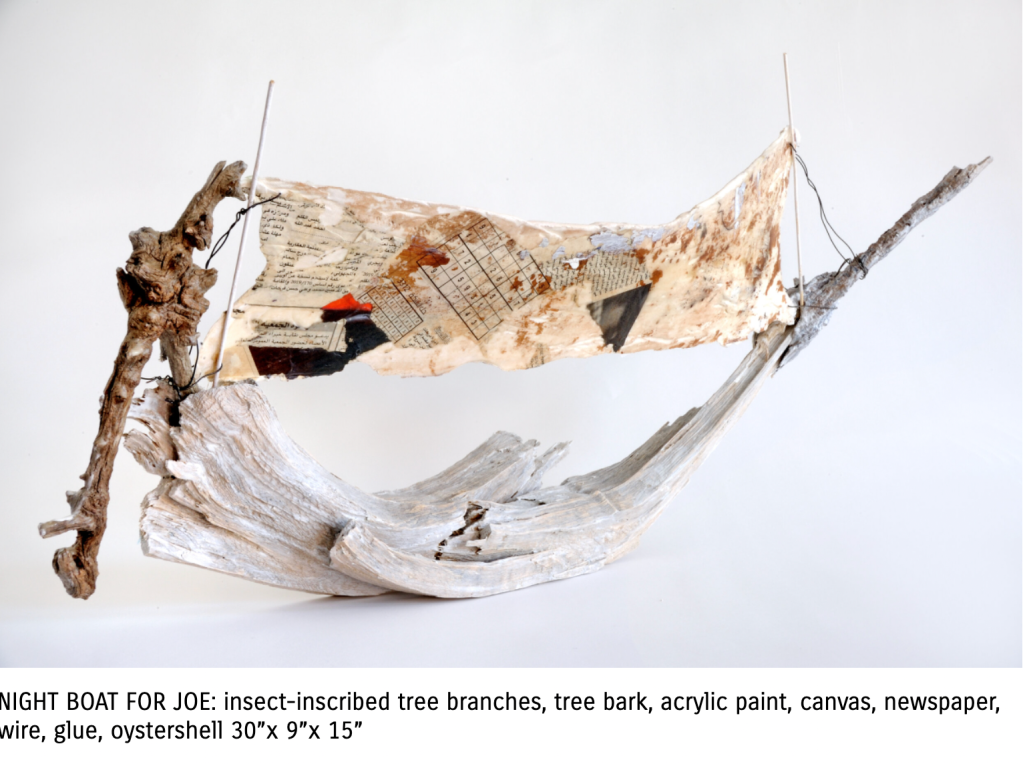The artwork of Micheline Klagsbrun will be on view in a solo exhibition at the Studio Gallery in Washington DC titled Crossings (April 27- May 21, 2022- Reception: May 7, 3-6 pm). In the meantime it is featured in the exhibition Creative Quest: Artists from the Holocaust’s Second Generation at the Howard County Arts Council (Baltimore area).

Her work springs both from her personal and family experience and reflects the current turmoil of uprooted people everywhere. Creative Quest raises the issue of how the effects of this turmoil and dislocation reverberate down through generations. The synchrony of these two shows could not be more timely when war and populism are at the forefront of our societies.
Klagsbrun’s exhibition expands on her vision of Night Boats as shown in 2021. Wall-hung mixed-media work will be displayed together with a new fleet of Night Boat sculptures, addressing the notion of a fraught crossing from one place to another. The works are patched together from a variety of media and found objects, seemingly fragile yet in fact resilient, representing perilous voyages into the unknown.
The artist shared about her artistic path, her studies in France and her current show. She hopes that her “work can bring some healing or joy to people on an individual scale instead”. Interview with an artist with a message to the world.


Can you share about your work and your upcoming solo exhibition?
For many years my theme has been transformation: moments of flux when new forms are born. I create layers that combine many media – pastel, color pencil, ink, paint, collage – evoking the co-existence of different meanings in the same form. My sculptures continue this theme: combining fragments of drawings with found elements- branches, bark, bones, rusted metal.
This type of work also contains layers of history and memory.
A few years ago I began a series of sculptures I call Night Boats, inspired by the discovery of a ship’s log recording my father’s 1941 escape to the UK from Lisbon, and the tragic history of that ship. The works are patched together from a variety of media and found objects, seemingly fragile yet in fact resilient, representing perilous voyages into the unknown. These sculptures, combined with mixed-media hangings and works on paper, form the exhibition Crossings.
What would you like your viewers to get from the exhibition?
Crossings embodies the notion of a fraught crossing from one place to another. In this exhibition, I revisit my family memories of dislocation and migration. At the same time, this work echoes the ongoing plight of refugees and asylum seekers everywhere, a tragic constant in our daily news.
Crossings also alludes to more symbolic voyages into the unknown: the journey of the soul through the Underworld and all the journeys we take when we close our eyes at night. On some pieces I transcribe hieroglyphic passages from the Egyptian “Book of the Dead”, a handbook for navigating the soul’s journey into the afterlife. Physical gaps in the work, that appear to be filled with light or with stormy darkness, are spanned by delicate threads and illusions. I hope that this powerfully evocative work is both timely and timeless.

Nature is a source of inspiration. Can you detail how you integrate it in your work?
Transformation is integral to the cycles of nature. Trees, plants, animals have always been a source of inspiration for me.
In my studio, I surround myself with a collection of scavenged animal and plant ephemera that inevitably finds its way into my hybrid forms. I am drawn to these materials by the expressiveness of their shapes and their symbolic quality. A hollow twisted branch can evoke grace, tragedy, resilience. I feel a reverence for the spirit and memory contained in a skull, a feather, a twisted shell: they contain traces of history, of different species, of a landscape.
You have studied in France. How did that impact your artistic path ?
Years ago, I spent a year studying with a Chilean émigré in Paris, Alfredo Echeverria. It was a moment when I was in transition from my first life as a clinical psychologist, but I did not yet know that. I had always created a space in my life in which to make art, usually at night, and this was the first time that I could dedicate long periods of time to looking and painting. Alfredo taught me to mix pigments from scratch, to take time, to take myself seriously. In his studio I painted a self-portrait. I will never forget entering that space one day and glimpsing the half-finished portrait from afar – I stopped in my tracks and felt dizzy with shock – it was a portrait of my dead father. I can say that through the studio experience with Alfredo I fell under the compulsive spell – I knew I could not stop making art.
What is your dream project?
My dream project is always changing. Right now, as I find myself compelled to make more Night Boats, I dream of creating a lifesize boat that could actually navigate rivers.
I admire artists who have large-scale projects that improve the world and bring some form of social change. My art brain does not seem to work in those ways, despite the fact that I engage with such artists and do my best to support them. I just hope that my work can bring some healing or joy to people on an individual scale instead.
CROSSINGS -Studio Gallery, 2108 R St NW DC 20008
April 27- May 21, 2022- Reception: May 7, 3-6 pm

Photos by courtesy of the artist

